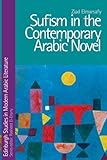Sufism in the Contemporary Arabic Novel / Ziad Elmarsafy.
Material type: TextSeries: Edinburgh Studies in Modern Arabic Literature : ESMALPublisher: Edinburgh : Edinburgh University Press, [2022]Copyright date: ©2012Description: 1 online resource (256 p.)Content type:
TextSeries: Edinburgh Studies in Modern Arabic Literature : ESMALPublisher: Edinburgh : Edinburgh University Press, [2022]Copyright date: ©2012Description: 1 online resource (256 p.)Content type: - 9780748641406
- 9780748655649
- 810
- online - DeGruyter
| Item type | Current library | Call number | URL | Status | Notes | Barcode | |
|---|---|---|---|---|---|---|---|
 eBook
eBook
|
Biblioteca "Angelicum" Pont. Univ. S.Tommaso d'Aquino Nuvola online | online - DeGruyter (Browse shelf(Opens below)) | Online access | Not for loan (Accesso limitato) | Accesso per gli utenti autorizzati / Access for authorized users | (dgr)9780748655649 |
Frontmatter -- Contents -- Series Editor’s Foreword -- Abbreviations -- Acknowledgements -- Introduction: Ouverture -- 1 Naguib Mahfouz: (En)chanting Justice -- 2 Tayeb Salih: The Returns of the Saint -- 3 Maḥmūd Al-Masʿadī: Witnessing Immortality -- 4 The Survival of Gamal Al-Ghitany -- 5 Ibrahim Al-Koni: Writing and Sacrifice -- 6 Tahar Ouettar: The Saint and the Nightmare of History -- Epilogue: Bahaa Taher, Solidarity and Idealism -- Notes -- Bibliography -- Index
restricted access online access with authorization star
http://purl.org/coar/access_right/c_16ec
Close readings of 9 contemporary Arab novelists who use Sufism as a literary strategySufi characters – saints, dervishes, wanderers – occur regularly in modern Arabic literature. A select group of novelists interrogates Sufism as a system of thought and language. In the work of writers like Naguib Mahfouz, Gamal Al-Ghitany, Taher Ouettar, Ibrahim Al-Koni, Mahmud Al-Mas’adi and Tayeb Salih we see a strong intertextual relationship with the Sufi masters of the past, including Al-Hallaj, Ibn Arabi, Al-Niffari and Al-Suhrawardi. This relationship interrogates the limits of the creative self, individuality, rationality and all the possibilities offered by literature. In this dialogue with the mystical heritage, these novelists seek a way of preserving a self under siege from the overwhelming forces of oppression and reaction that characterised the late 20th and early 21st centuries.
Mode of access: Internet via World Wide Web.
In English.
Description based on online resource; title from PDF title page (publisher's Web site, viewed 29. Jun 2022)


